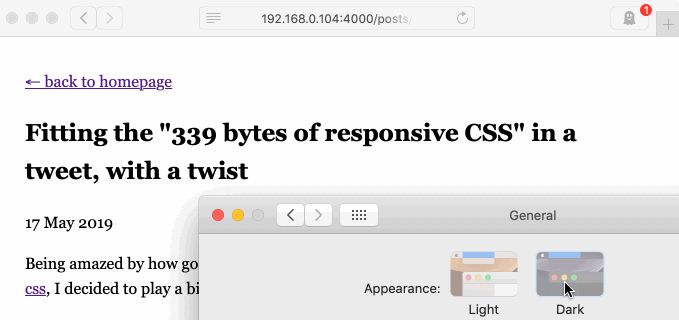Fitting the "339 bytes of responsive CSS" in a tweet, with a twist published on 17 May 2019, 1 minute read
Being amazed by how good and functional a web page can be by just using 339 bytes of css, I decided to play a bit with it and adapt it to my needs.
The styling of the post you are reading right now, (minified, except syntax highlighting css) fits in a tweet. It has the following features:
- responsive - looks good on any screen
- is friendly to source code
- does not use external fonts to save bytes and the planet
- it supports Safari’s dark mode
Here’s how the dark mode switching looks in action:

And here’s the unminidied, annotated source:
body {
font-family: Georgia, serif;
line-height: 1.6;
/* when you use relative units, stuff looks good on any screen */
max-width: 40rem;
padding: 2rem;
margin: auto;
}
img {
/* make sure that all images fit in the viewport */
max-width: 100%;
}
pre {
/* add a line to separate code blocks visually from usual text */
border: 1px solid #eee;
border-width: 1px 0;
/* Pre blocks don't wrap (and shouldn't). Scroll their content in case
they overflow so that the viewport size stays the same */
overflow-y: scroll;
}
@media (prefers-color-scheme:dark) {
body {
/* the dark mode just inverts everything, using a black background */
filter: invert(1);
background-color: black;
}
img {
/* the invert filter above inverts images as well, so we'll need
to revert that effect */
filter: invert(1);
}
}
Read more posts
- On logic in a Rails app, revisited 6 years later 18 May 2019
- Enforcing that a ruby method is called from a specific location 28 Jun 2017
- Log filename, line and function name in ruby automatically 11 May 2013
- Unity performance tweaks 20 Mar 2013
← back to homepage